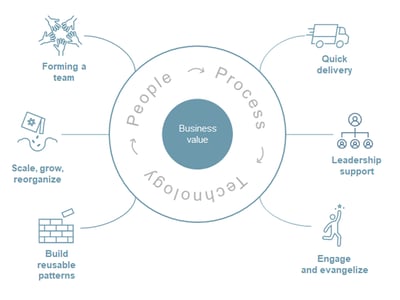Six success factors for a Cloud Center of Excellence
The Cloud Center of Excellence (CCoE) is a phenomenon we often see at our customers. But what is a CCoE all about? And why would you need one? To answer that question, we examine the fundamentals and key success factors of a CCoE.
The Cloud Center of Excellence is not a completely new concept. The Center of Excellence, in general, is a definition that has existed in manufacturing environments for over 30 years. To summarize: a Center of Excellence is all about centralizing a group of experts, who work in a particular area and have the task to improve an important element of the business or organization. They do so by adopting best practices, performing research, providing support, organizing training, and so on.
Bowie Bartels on the rise of the Cloud Center of Excellence
The three biggest cloud providers – AWS, Microsoft, and Google – all provide support to set up a CCoE. They have learned from existing management principles and change models, and they have certainly also learned from each other. As a result, they all have an extensive library of methodologies, tools, and frameworks available to set up a Cloud Center of Excellence; as long as you combine them with the right people. In the context of a CCoE, methodologies consist of best practices. Tools are typically focused on automation or security services. And frameworks are related to reference architectures and the best team setup for being successful.
Why a Cloud Center of Excellence?
We see that a CCoE is mostly put in place at larger organizations – enterprises and (upper) mid-market companies. The reason is not surprising: in big organizations, changes and transformations take time, and hence the adoption of cloud is no different. There are several issues a CCoE helps to resolve.
Firstly: organizational structures in enterprises are often complex, and top-down approaches have proven to be slow or less successful. The second issue is the unknown. Many organizations who want to use cloud simply do not know where to start, or they build traditional IT patterns in the cloud – which is not how it is intended to be used. The third issue is decentralization: in large enterprises cloud is already being used, but spread out over multiple departments or business units. Such teams are often disconnected and do not share knowledge or experiences. And with that comes a lack of transparency. A CCoE can counter this decentralization.
So, a CCoE accelerates the adoption of cloud, ensures effective cloud usage, and centralizes decoupled cloud services. A CCoE achieves this not by being restrictive, but by providing freedom in a more controlled way.
Challenges
When implementing a CCoE, the responsibility shifts from a dedicated IT department to the teams that are using a CCoE themselves. These teams — for example, a business team — are often not used to dealing with IT resources. They are usually not used to working with cloud, so they have to expand their knowledge, and learn about the components that are available; how to use them, and how to set them in code, for example. Security is also one very important aspect that people tend to forget about, that definitely should not be overlooked. And where you would previously use resources procured by IT without ever having to think about the cost of running it, with a CCoE you must manage the costs and keep them under control yourself.
Success factors
So, what makes a CCoE successful? How can you organize it in a way that creates business value? You need the right people, repeatable steps and processes, and you want to make effective use of technology. These are the six key success factors for a Cloud Center of Excellence:

1. Forming a team
The first thing you need is a strong, multidisciplinary team. From a soft skill side, you want people who are experiment-driven. People who know how to learn from failure can iterate quickly and are not afraid to challenge. A strong customer focus is important for each individual, as well as for the team as a whole. In terms of hard skills, the CCoE requires a diverse set of skills. You need cloud architects for the platform you are onboarding – AWS, Microsoft Azure, or Google Cloud. You also need DevOps team members; people that are familiar with software and have a background in automation or data. Moreover, you need people with knowledge of network and IT security; these topics are often subject to difficult discussions when onboarding cloud. And you need someone who understands the impact of changes on workflows, processes, and procedures within the organization.
2. Quick delivery
The second is quick delivery. If you want to be successful, narrow down your focus – start working on something small but effective. This way you can showcase what you have created to the rest of the organization and shift the dialogue to what is possible, rather than what is unknown.
3. Leadership support
It is important to have leadership support. A sponsor who conveys a clear message to the rest of the company. Someone who helps to announce and promote the CCoE, and to communicate the challenges the organization has, why the team is put in place, and what you want to achieve. This message should be strong and clear across the entire organization.
4. Engage and evangelize
Engagement and evangelization are also key to success. As a team, and as an individual, you should engage with your (internal) customers and users. You can do this by organizing sessions to share information, giving training sessions, inviting customers to talk about use cases, and showing successful cloud projects you have already delivered.
5. Build reusable patterns
The fifth success factor is building reusable patterns. Think of artifacts that describe the standards and guidelines that allow a team or an application to onboard quickly. Think about your automation platform and the repeatable steps that you have in place. Reduce operational overhead by standardizing. You still want to provide freedom, but in a controlled way. Also think about the way security services are configured by default, and about transferring responsibilities from the CCoE to teams that are responsible for their own workload.
6. Scale, grow, reorganize
The final element that makes a CCoE successful is the ability to scale, grow, and reorganize itself. Federate the CCoE to business teams that lack the skills or knowledge to enable a DevOps way of working or enable services in the cloud. And make sure the CCoE is your central point for technical assistance.






